Publications
Research primarily consists of AI for Materials Synthesis Science.
2025
- Preprint
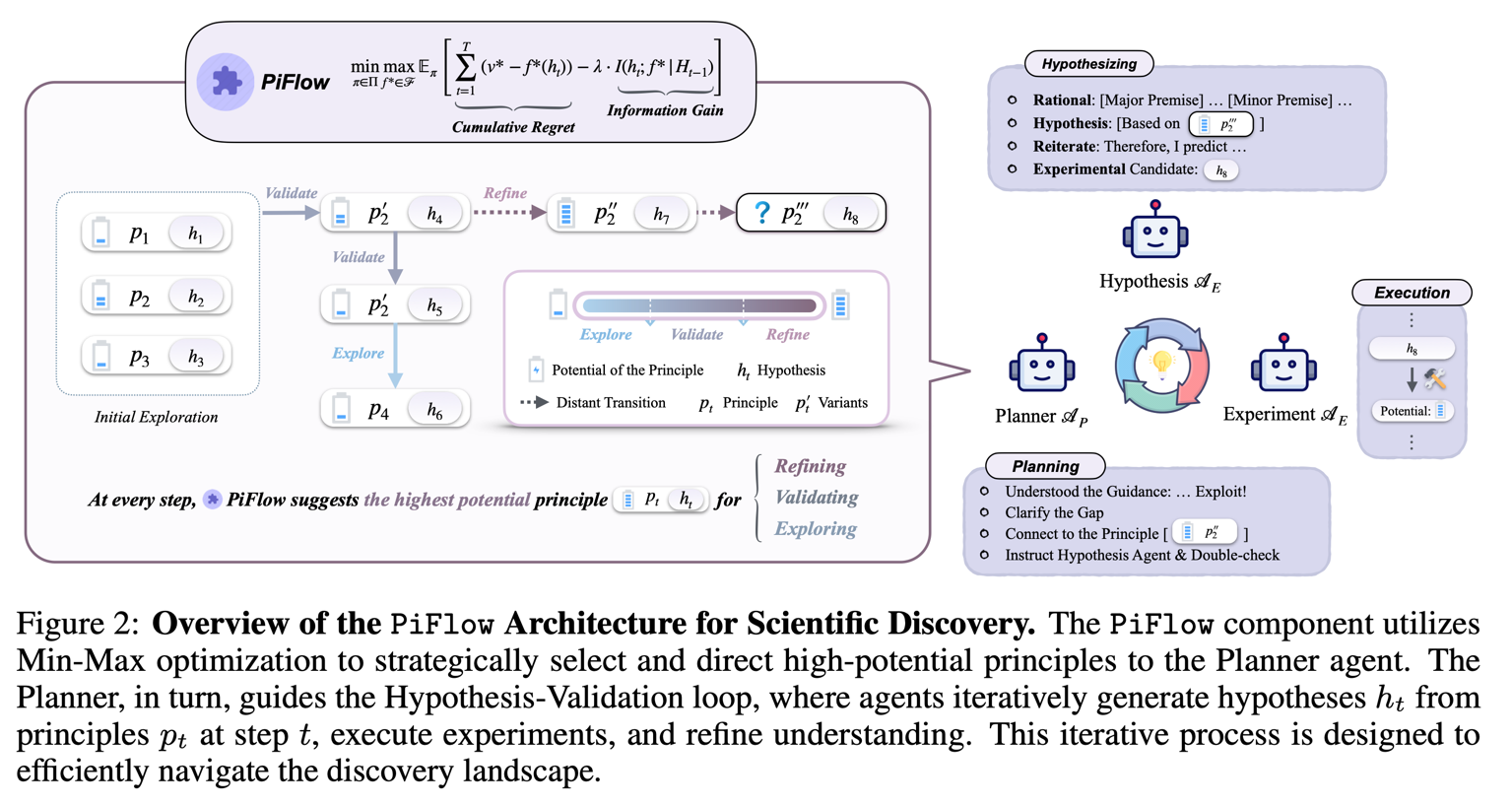 PiFlow: Principle-aware Scientific Discovery with Multi-Agent CollaborationYingming Pu, Tao Lin†, and Hongyu ChenIn arXiv, May 2025
PiFlow: Principle-aware Scientific Discovery with Multi-Agent CollaborationYingming Pu, Tao Lin†, and Hongyu ChenIn arXiv, May 2025🏅Best Poster Award at Westlake International Symposium in Engineering (2025)
Large Language Model (LLM)-based multi-agent systems (MAS) demonstrate remarkable potential for scientific discovery. Existing approaches, however, often automate scientific discovery using predefined workflows that lack rationality constraints. This often leads to aimless hypothesizing and a failure to consistently link hypotheses with evidence, thereby hindering systematic uncertainty reduction. Overcoming these limitations fundamentally requires systematic uncertainty reduction. We introduce \textttPiFlow, an information-theoretical framework, treating automated scientific discovery as a structured uncertainty reduction problem guided by principles (e.g., scientific laws). In evaluations across three distinct scientific domains – discovering nanomaterial structures, bio-molecules, and superconductor candidates with targeted properties – our method significantly improves discovery efficiency, reflected by a 73.55% increase in the Area Under the Curve (AUC) of property values versus exploration steps, and enhances solution quality by 94.06% compared to a vanilla agent system. Overall, \textttPiFlow serves as a Plug-and-Play method, establishing a novel paradigm shift in highly efficient automated scientific discovery, paving the way for more robust and accelerated AI-driven research.
(Remark: An Unified framework with strong theoretical guarantee for scientific discovery. )@inproceedings{pu2025piflow, title = {PiFlow: Principle-aware Scientific Discovery with Multi-Agent Collaboration}, author = {Pu, Yingming and Lin, Tao and Chen, Hongyu}, booktitle = {arXiv}, year = {2025}, month = may, url = {https://arxiv.org/abs/2505.15047}, } - AI4Mat 2025
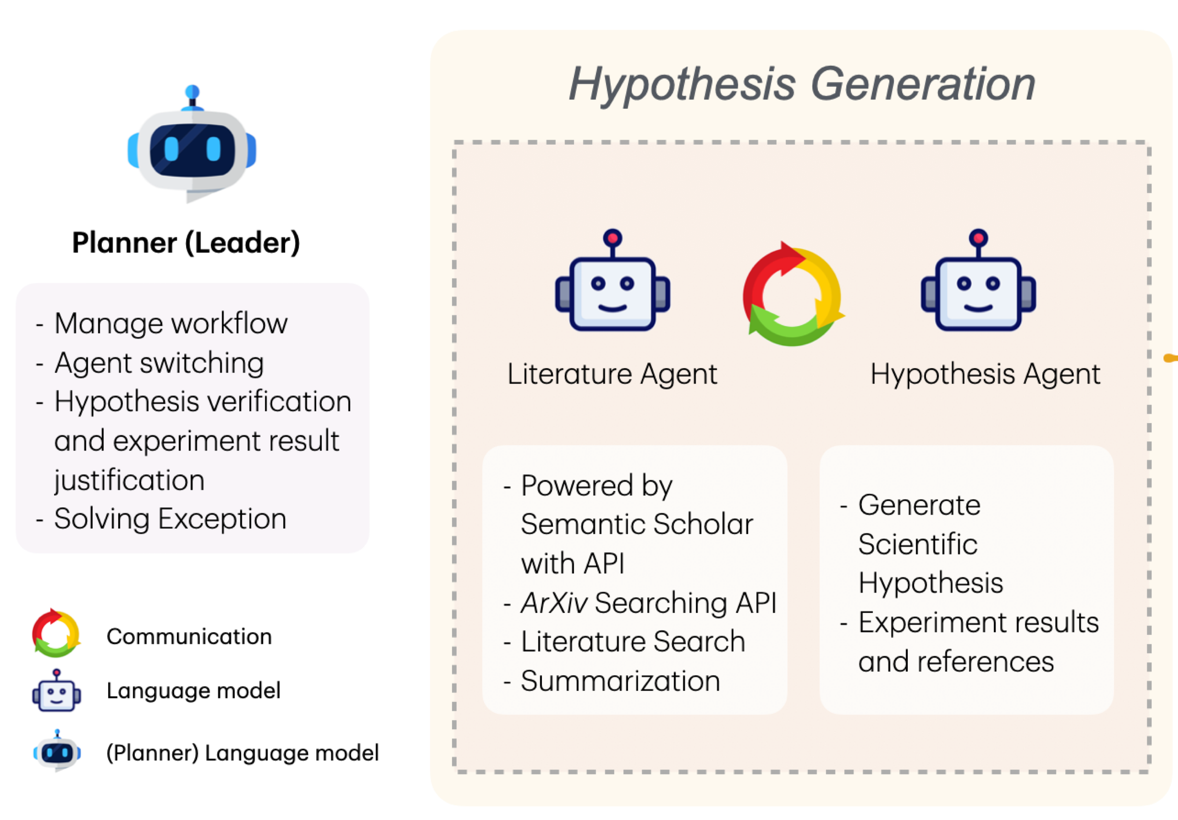 PriM: Principle-Inspired Material Discovery through Multi-Agent CollaborationRyan Zheyuan Lai*, and Yingming Pu†In AI for Accelerated Materials Design - ICLR 2025, Mar 2025
PriM: Principle-Inspired Material Discovery through Multi-Agent CollaborationRyan Zheyuan Lai*, and Yingming Pu†In AI for Accelerated Materials Design - ICLR 2025, Mar 2025Complex chemical space and limited knowledge scope with biases holds immense challenge for human scientists, yet in automated materials discovery. Existing intelligent methods relies more on numerical computation, leading to inefficient exploration and results with hard-interpretability. To bridge this gap, we introduce a principles-guided materials discovery workflow powered by language inferential multi-agent system (MAS). Our framework integrates automated hypothesis generation with experimental validation in a roundtable system of MAS, enabling systematic exploration while maintaining scientific rigor. Based on our framework, the case study of nano helix demonstrates higher materials exploration rate and property value while providing transparent reasoning pathways. This approach develops an automated-and-transparent paradigm for material discovery, with broad implications for rational design of functional materials.
@inproceedings{pu2025prim, title = {PriM: Principle-Inspired Material Discovery through Multi-Agent Collaboration}, author = {Lai, Ryan Zheyuan and Pu, Yingming}, booktitle = {AI for Accelerated Materials Design - ICLR 2025}, year = {2025}, month = mar, url = {https://openreview.net/pdf?id=lhobZk76wX}, } - Adv. Opt. Mat.
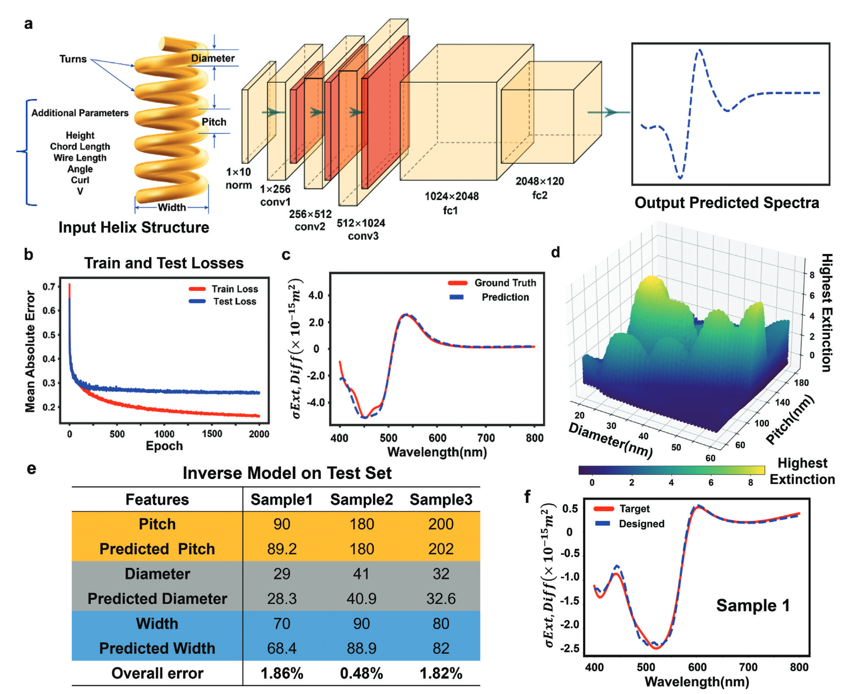 Machine Learned Structure-Property Correlation Between Nanohelices and Circular DichroismJuanshu Wu, Yingming Pu, Jin Wang, Bing Gu, and 2 more authorsAdvanced Optical Materials, Feb 2025
Machine Learned Structure-Property Correlation Between Nanohelices and Circular DichroismJuanshu Wu, Yingming Pu, Jin Wang, Bing Gu, and 2 more authorsAdvanced Optical Materials, Feb 2025Rational design of chiral nanostructures with desired Circular Dichroism (CD)spectra requires a quantitative structure-property relationship, which has sofar been unavailable. Using a data-driven method, the aim is to establish sucha relationship for nanohelices, a prevalent structural element of chiralnanostructures. Given the challenges in synthesizing nanohelices andseparating racemic mixtures, obtaining extensive CD data has been difficult.Instead, CD spectra of 1260 nanohelices are stimulated using finite-differencetime-domain method. This dataset is used to train a convolutional neuralnetwork that can accurately predict the CD spectra using a few key structuralparameters such as pitch and curl. Moreover, an inverse design model isdeveloped that can generate the right helix with the desired CD. To establishquantitative relationships, Shapley Additive explanations analysis and casestudies are devised for the prediction model. The algorithm efficientlyanalyzes the structure-property correlation, revealing the specific degrees ofstructural influence on the spectroscopic characteristics. Furthermore, theneural-network-based model can be extended via transfer learning to predictCD spectra of nanohelices made of other noble metals (Ag, Cu). It is believedthat AI-based approaches can significantly broaden the scope ofwet-chemistry nanosynthesis and computational techniques in the design ofchiral nanostructures.
@article{wu2025machine, title = {Machine Learned Structure-Property Correlation Between Nanohelices and Circular Dichroism}, author = {Wu, Juanshu and Pu, Yingming and Wang, Jin and Gu, Bing and Chen, Xin and Chen, Hongyu}, journal = {Advanced Optical Materials}, year = {2025}, month = feb, doi = {10.1002/adom.202402595}, }
2024
- AI4Mat 2024
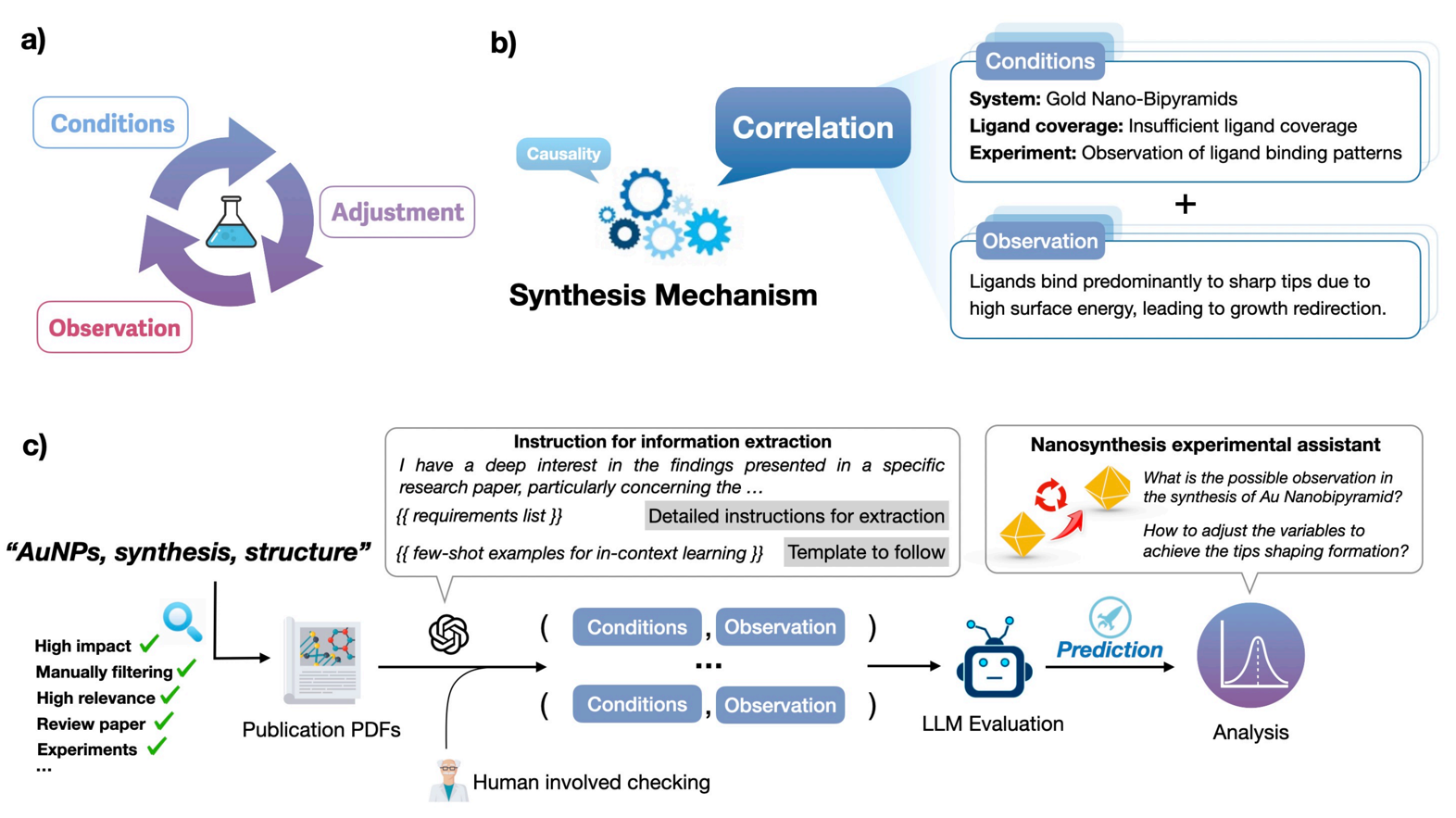 Leveraging Large Language Models for Explaining Material Synthesis Mechanisms: The Foundation of Materials DiscoveryYingming Pu, Liping Huang, Tao Lin, and Hongyu ChenIn AI for Accelerated Materials Design - NeurIPS 2024, Nov 2024
Leveraging Large Language Models for Explaining Material Synthesis Mechanisms: The Foundation of Materials DiscoveryYingming Pu, Liping Huang, Tao Lin, and Hongyu ChenIn AI for Accelerated Materials Design - NeurIPS 2024, Nov 2024🏅1st Poster Award at AI for Energy Materials Conference 2024
Large language models (LLMs) have attracted significant attention in the advancement of materials discovery, particularly in their role in automation and robotics. However, a key question remains: Do these models operate based on a true grasping of physicochemical principles when designing experiments or interpreting results? Existing evaluations primarily focus on fact-checking tasks such as material property prediction and named entity recognition, while neglecting the reasoning required to grasp fundamental synthesis mechanisms. Furthermore, no previous studies have directly evaluated LLMs’ ability to reason about synthesis mechanisms. To address these challenges, we first develop a benchmark containing 775 semi-manually created multiple-choice questions in the field of gold nanoparticles (AuNPs) synthesis for evaluation. Second, we probe the model’s output logits to derive precise selection probabilities for the correct answers, obtaining a confidence-based score (c-score) as a quantitative evaluation metric. Additionally, based on this evaluation, we also develop an AI assistant using retrieval-augmented generation (RAG) to explain AuNP synthesis mechanisms, achieving a 10% improvement in accuracy over the leading model, Claude. Our study highlights the potential of LLMs in recogniz scientific mechanisms and offers a valuable tool for aiding the exploration of more synthesis methods. Moreover, our dataset establishes a foundation for developing highly efficient models with the utilization of material synthesis mechanisms.
@inproceedings{pu2024leveraging, title = {Leveraging Large Language Models for Explaining Material Synthesis Mechanisms: The Foundation of Materials Discovery}, author = {Pu, Yingming and Huang, Liping and Lin, Tao and Chen, Hongyu}, booktitle = {AI for Accelerated Materials Design - NeurIPS 2024}, year = {2024}, month = nov, url = {https://openreview.net/forum?id=I6jYRbaai8}, }
2023
- Adv. Mat.
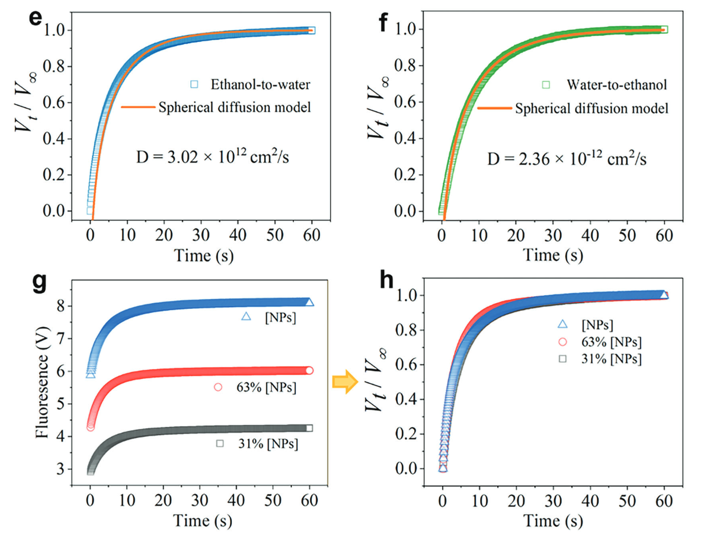 Measuring Solvent Exchange in Silica Nanoparticles with Rotor-based FluorophoreXuejun Cheng, Yingming Pu, Songtao Ye, Xiao Xiao, and 2 more authorsAdvanced materials, Nov 2023
Measuring Solvent Exchange in Silica Nanoparticles with Rotor-based FluorophoreXuejun Cheng, Yingming Pu, Songtao Ye, Xiao Xiao, and 2 more authorsAdvanced materials, Nov 2023Measuring the diffusivity of molecules is the first step toward understanding their dependence and controlling diffusion, but the challenge increases with the decrease of molecular size, particularly for non-fluorescent and non-reactive molecules such as solvents. Here, the capability to monitor the solvent exchange process within the micropores of silica with millisecond time resolution is demonstrated, by simply embedding a rotor-based fluorophore (thioflavin T) in colloidal silica nanoparticles. Basically, the silica provides an extreme case of viscous microenvironment, which is affected by the polarity of the solvents. The fluorescence intensity traces can be well fitted to the Fickian diffusion model, allowing analytical solution of the diffusion process, and revealing the diffusion coefficients. The validation experiments, involving the water-to-ethanol and ethanol-to-water solvent exchange, the comparison of different drying conditions, and the variation in the degree of cross-linking in silica, confirmed the effectiveness and sensitivity of this method for characterizing diffusion in silica micropores. This work focuses on the method development of measuring diffusivity and the high temporal resolution in tracking solvent exchange dynamics over a short distance (within 165 nm) opens enormous possibilities for further studies.
@article{Cheng2023MeasuringSE, title = {Measuring Solvent Exchange in Silica Nanoparticles with Rotor-based Fluorophore}, author = {Cheng, Xuejun and Pu, Yingming and Ye, Songtao and Xiao, Xiao and Zhang, Xin and Chen, Hongyu}, journal = {Advanced materials}, year = {2023}, pages = {e2305779}, }
2022
- Preprint
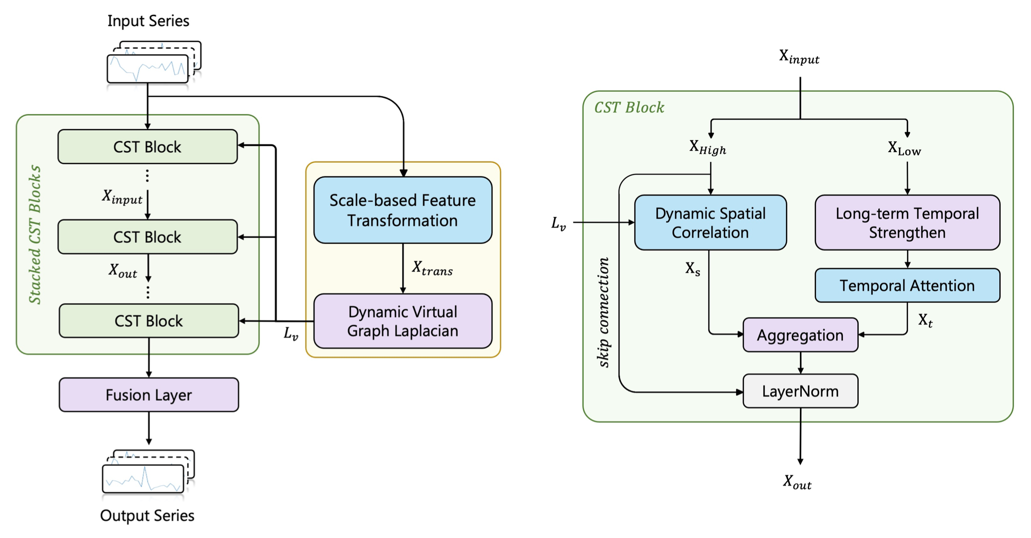 Combined Dynamic Virtual Spatiotemporal Graph Mapping for Traffic PredictionYingming Pu*†arXiv preprint arXiv:2210.00704, Nov 2022
Combined Dynamic Virtual Spatiotemporal Graph Mapping for Traffic PredictionYingming Pu*†arXiv preprint arXiv:2210.00704, Nov 2022The continuous expansion of the urban construction scale has recently contributed to the demand for the dynamics of traffic intersections that are managed, making adaptive modellings become a hot topic. Existing deep learning methods are powerful to fit complex heterogeneous graphs. However, they still have drawbacks, which can be roughly classified into two categories, 1) spatiotemporal async-modelling approaches separately consider temporal and spatial dependencies, resulting in weak generalization and large instability while aggregating; 2) spatiotemporal sync-modelling is hard to capture long-term temporal dependencies because of the local receptive field. In order to overcome above challenges, a \textbfCombined \textbfDynamic \textbfVirtual spatiotemporal \textbfGraph \textbfMapping \textbf(CDVGM) is proposed in this work. The contributions are the following: 1) a dynamic virtual graph Laplacian (DVGL) is designed, which considers both the spatial signal passing and the temporal features simultaneously; 2) the Long-term Temporal Strengthen model (LT2S) for improving the stability of time series forecasting; Extensive experiments demonstrate that CDVGM has excellent performances of fast convergence speed and low resource consumption and achieves the current SOTA effect in terms of both accuracy and generalization.
@article{pu2022combined, title = {Combined Dynamic Virtual Spatiotemporal Graph Mapping for Traffic Prediction}, author = {Pu, Yingming}, journal = {arXiv preprint arXiv:2210.00704}, year = {2022} }